Welcome!
This teacher guide is a companion piece to Monona Terrace’s student programs. Using Frank Lloyd Wright’s architecture as a text, our programs can enrich your STEM, social studies, language arts, and art curriculum.
Tour and program facilitation is inquiry-based and encourages students to articulate their ideas, use reasoning, and make applications to real-world scenarios. All offerings are designed to support Common Core and state academic standards. Student programs and tours are designed for 2nd grade and above (7 yrs. and older).
About Frank Lloyd Wright and Monona Terrace
Monona Terrace Community and Convention Center was designed by the world-renowned architect Frank Lloyd Wright. He spent more than 70 years of his life creating designs that revolutionized the art and architecture of the 20th century. Many innovations in today’s buildings are products of his imagination. In total, he created 1,141 designs – including homes, offices, churches, schools, libraries, bridges, museums and other types of structures. Of those, 532 were actually constructed and today 409 still remain in existence. But Wright didn’t just design structures, he also designed furniture, glass artwork, lamps, dinnerware, linens and the list goes on. To better place his creative mind into perspective – he was born in 1867, just two years after the Civil War ended and lived until 1959, two years after the first space satellite was sent into orbit; a remarkable time for a remarkable man.
Monona Terrace opened its doors on July 18, 1997, after nearly 60 years of controversy. This beautiful facility is located on the shore of Lake Monona, and was first designed by Frank Lloyd Wright in 1938 as a cultural, governmental and recreational building. Wright reworked the design several times between 1938 and 1958 before signing off on the final plans seven weeks before his death in 1959. In 1992, Madison residents voted to construct Monona Terrace- on the Lake Monona site originally proposed by Wright- as a community and convention center. While Wright’s final 1959 design was used for the building’s exterior, the interior was redesigned by Wright’s apprentice and Taliesin architect Anthony Puttnam.
Today this magnificent 5-level, 352,610 square foot structure hosts national and community events, and is an architectural destination for thousands of visitors every year.
Pre-Visit Discussion
Monona Terrace’s Architect, Frank Lloyd Wright
Vocabulary words in bold type
Architect Frank Lloyd Wright (1867-1959) sat at his drafting table and looked at his drawings for a city auditorium called Monona Terrace. He had designed hundreds of buildings in his lifetime… but this one was unusual. For over twenty years, government officials disagreed
about the building plans and about whether Wright should be architect. And yet Wright believed that the people of Madison, his hometown, would eventually build Monona Terrace to add a special building to this beautiful city.
What did Frank Lloyd Wright design in his career?
Frank Lloyd Wright worked on over 1000 designs for all kinds of buildings, including homes,churches, offices and public buildings. Wright also created all of the parts inside a building, like furniture, fabric, and stained glass windows. He even gave one of his clients a doghouse!
What were his childhood experiences?
Wright lived in southwestern Wisconsin for most of his life. He grew up in Madison and spent summers with his relatives in the country. Young Frank loved to spend time outdoors. His nature walks took him through woods, hills and valleys. He and his friends raced ice-boats on
the Madison lakes.
At age nine Frank received a set of Froebel (froy-ble) blocks from his mother, and it quickly became his favorite toy. He was inspired by the shapes of the blocks and began to see that geometry was everywhere in the world around him.
Why were his ideas so different?
Frank Lloyd Wright’s architecture was very unique for its time. He called his buildings organic because he designed them to blend into their surroundings. He chose materials, shapes, colors, and textures to make the buildings appear as if they grew out of the ground.
As a designer, Wright thought about how a building would be functional for the people inside. He also wanted to make places that were beautiful, inspiring, and connected to nature. He believed that architecture could make our lives better.
What efforts took place so that Monona Terrace could finally be built?
In 1957, state lawmakers passed a bill that said no buildings over 20 feet tall could be built on the Lake Monona lakeshore. Frank Lloyd Wright died just two years later so he was unable to see construction of Monona Terrace. (The bill was finally repealed.) City leaders became interested in the project again in the 1980’s. One of Wright’s students was able to use the architect’s exterior plans to design a convention center. The citizens of Madison voted to approve the project in 1992, and in 1997 the building was finally completed!
Pre-visit Discussion Continued…
Conversation Starters:
1. What do you learn from toys or games that you play with?
2. What interests do you have that might lead to a career?
3. Why would Frank Lloyd Wright want to design the furniture and dishes for a house he designed?
Vocabulary
architect – person who designs and draws a building
cantilever – a free horizontal piece, such as a tree branch, that projects away from a support, such as a tree trunk
design – an outline, sketch or plan for an intended purpose exterior- outside
form – three-dimensional shape
Froebel blocks – educational toys invented by German Friedrich Froebel
function – use
geometry – branch of mathematics that studies shapes
green design – design that is environmentally responsible and resource-efficient
inspire – helps to spark an idea, gives one the urge to create
interior – inside
materials – what a structure is made of
organic architecture – buildings that are in harmony with, and draw inspiration from, the environment
plan – drawing that shows the building with its roof removed as seen from above
scale – size and proportion of a building in relation to the people who inhabit it
site – the geographic location of a building; the land on which a building is constructed
structure – arrangement of parts of a building to help it stand up
Student Handout:
What Does an Architect Consider
When Designing a Building?
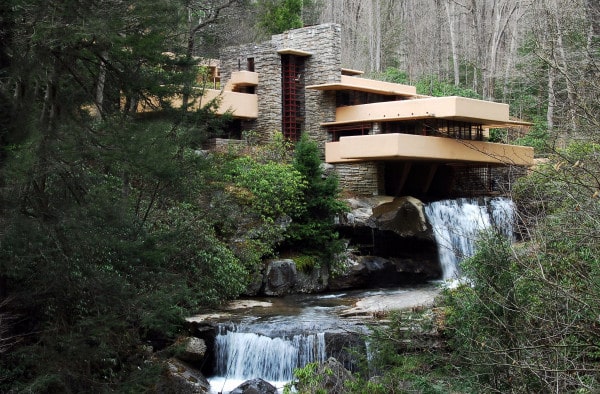
lachrimae72, CC0, via Wikimedia Commons
Site: the place where a building will be located
Site: the place where a building will be located The site chosen for a building will often influence an architect’s decisions about size, materials and shape. Frank Lloyd Wright encouraged his clients to build in natural settings like the one depicted in the photograph so they could be closer to nature.
Photo: Fallingwater Residence, Bear Run, Pennsylvania
Materials: what a structure is made of
For his home and studio buildings in Arizona, Wright designed concrete walls embedded with colorful rock found on the desert floor. He often chose local materials to make a structure look like it belonged in its environment.
Photo: Taliesin West, Scottsdale, Arizona
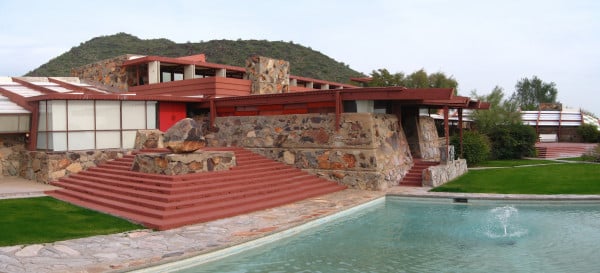
I, Gobeirne, CC BY-SA 3.0, via Wikimedia Commons
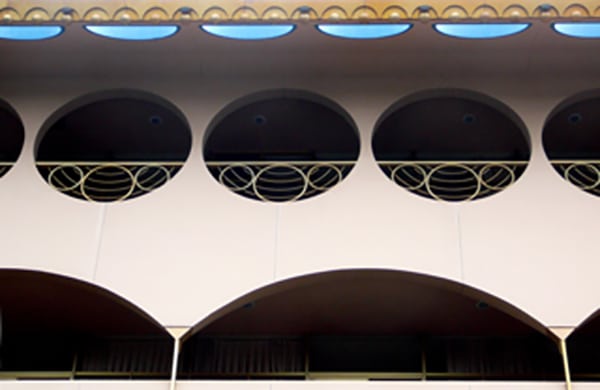
Rose Vekony, CC BY-SA 3.0, via Wikimedia Commons
Shape (two-dimensional) or Form (three-dimensional)
The Marin County Civic Center’s circular theme is an example of Wright carrying one main shape throughout a building’s exterior and interior design. With rooms, furniture and details using the same geometry, all the parts fit together and create a feeling of unity.
Photo: Marin County Civic Center, San Rafael, California
Scale: size and proportion of a building in relation to the people who inhabit it
Wright designed buildings with a human scale and low ceilings that created a feeling of shelter, as shown here at the entrance to the Unitarian Meeting House. Sometimes this more confining space introduces you to a larger one with higher ceilings and big windows so that the feeling of freedom is more powerful!
Photo: Unitarian Meeting House, Madison, Wisconsin
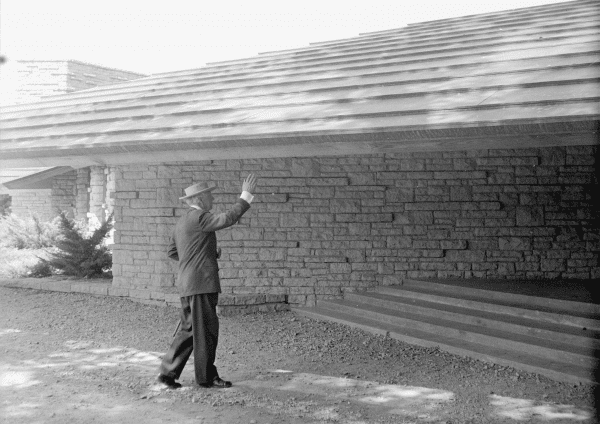
Photo credit: Wisconsin Historical Society, WHS-90723 (cropped from original)
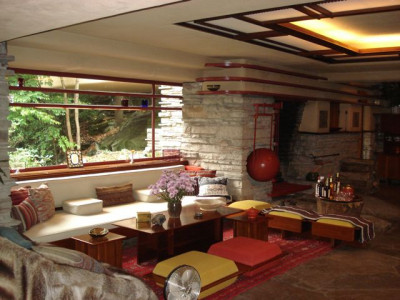
Jeffrey Neal at the English Wikipedia, CC BY-SA 3.0 , via Wikimedia Commons
Color
Designers often use color to create feelings. Color has the power to energize, to calm, or create other emotions. At Fallingwater, Wright chose a color palette of creams, greens and reds that would mimic stone and plant life at the site, and yellow and orange textiles to enliven the space.
Structure: arrangement of parts in a building to help it stand up
Wright designed tall, thin columns to support the weight of the ceiling of the Johnson Wax Company’s Great Workroom of the Johnson Wax Headquarters. He was required to test one first – it successfully supported 60 tons, much more than the 12 tons required. These columns were referred to as “dendriforms” because of their tree-like appearance. The supporting pads on top were called lily pads.
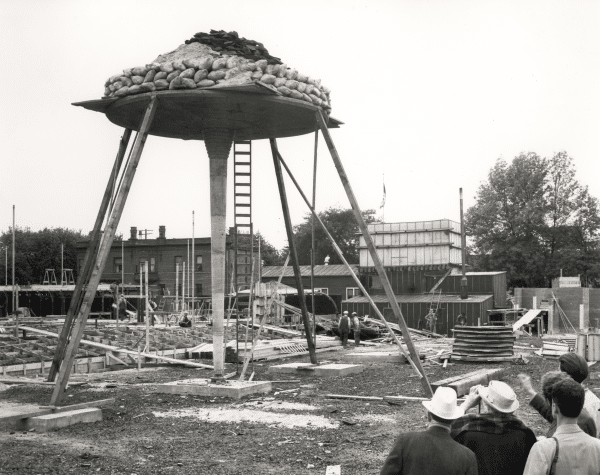
Photo: Construction site of S.C. Johnson Administration Building,
Racine, Wisconsin Credit: WHi-1911
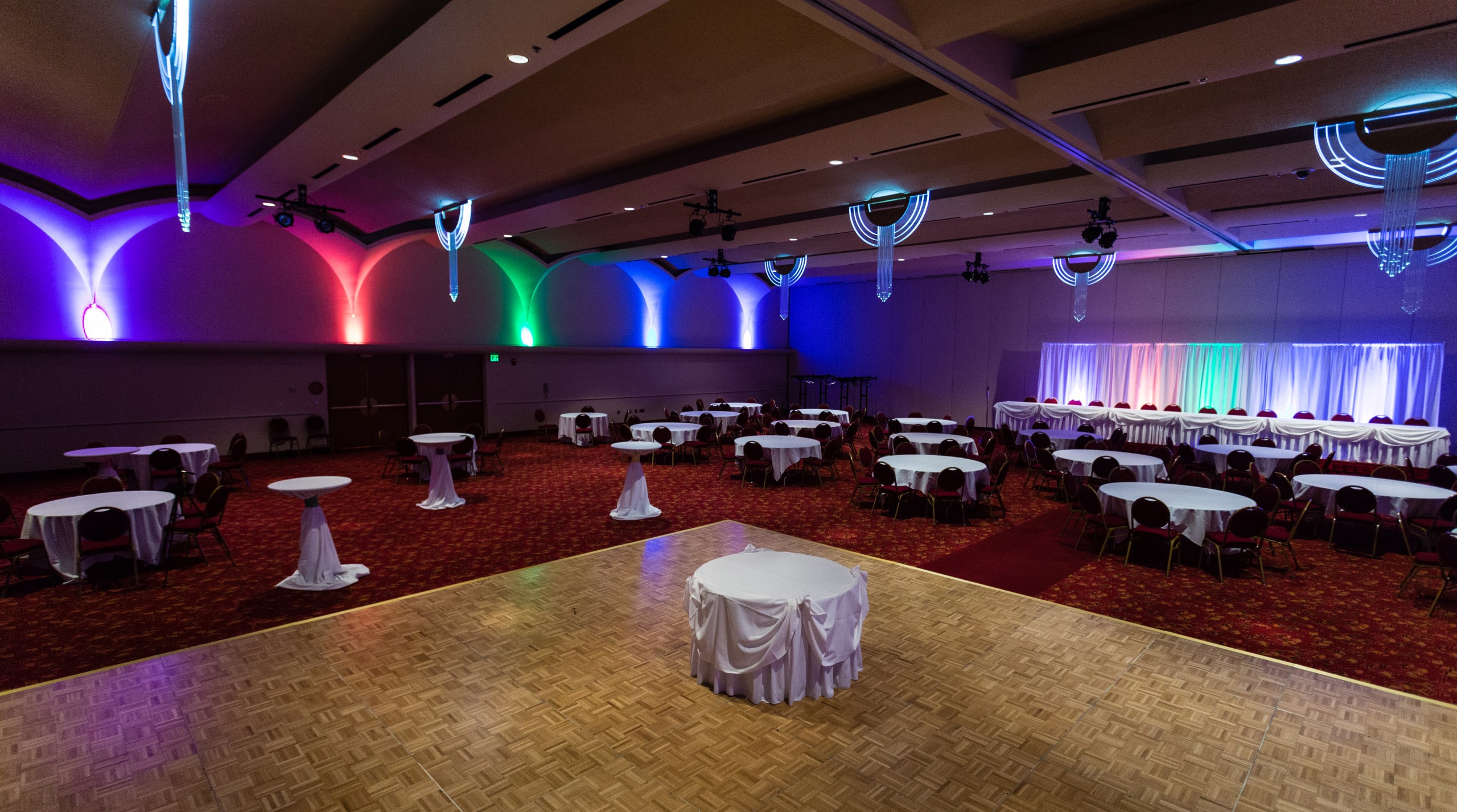
Function: use of a building
The Monona Terrace Ballroom is a large space of over 13,000 square feet, designed to accommodate a large event. Moveable walls can be pulled out to convert the large room to smaller ones. The result is a highly functional space that serves many different types of gatherings.
Photo: Monona Terrace Community and Convention Center, Madison, Wisconsin
Organic Architecture
Wright incorporated native materials and natural land features into his designs so that his buildings would blend in with their surroundings. He gave his home a Welsh name,” Taliesin,” translated to mean Shining Brow. The name refers to the location of the house built into the hill instead of on top. Today’s architects continue to practice “green” architecture by choosing materials and construction methods that are energy efficient and less harmful to the environment.
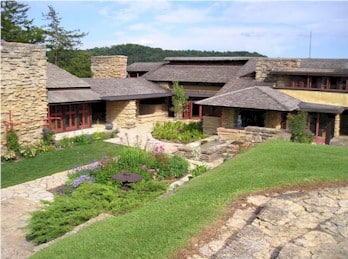
Marykeiran at English Wikipedia., CC BY-SA 3.0 , via Wikimedia Commons
Pre-Visit Activity
Reading a Building
Students will be asked to look closely at Monona Terrace’s architecture during their visit. In this activity, students practice observing details of another Frank Lloyd Wright-designed building.
Objectives:
- Students will understand that an architect makes choices about a building’s materials, shapes, colors and textures.
- Students will analyze and interpret Frank Lloyd Wright’s specific choices to create an organic building, or one that is harmonious with the site.
Observe and Describe
Review the activity to prepare for discussion. Print and disseminate the sheet marked “Student Handout.” Allow the students several minutes to make observations and write their responses to the worksheet questions:
- Describe the natural features of this site in Pennsylvania.
- Describe the shapes, colors and materials of the building.
- Describe two building features that Frank Lloyd Wright designed so that people could enjoy a view of the outdoors.
Invite the class to share their answers. You can add to the discussion with these facts about Fallingwater.
- The horizontal rectangular terraces give the building a low, flat profile.
- The building materials are concrete, steel and limestone. The limestone is native to the site- pieces have been put together to resemble how rock appears in nature. You cannot see the steel inside the concrete that strengthens the terraces.
- Projecting terraces provide private areas where you can enjoy nature. The Kaufmann Family would often eat meals or read on the terraces. The continuous band of windows means that your view is not interrupted.
Analyze and Interpret
Ask students analytical questions to probe further into Wright’s design.
- Do you think any parts of the design were inspired by the site?
- Do you think the building is harmonious with the surroundings as Wright intended? Why?
- What kind of experience did he want the inhabitant to have at Fallingwater?
- Imagine you were at Fallingwater. What would you see, hear and smell?
- If you were to describe the building, what simile would you use? Fallingwater is like…
-
- a stack of waffles?
- a box with open drawers?
- Something else?
Background Information
Wait to share this background information with students until after they have engaged in close looking and describing.
In 1934 Frank Lloyd Wright accepted a job that would change his life forever. His client, Edgar Kaufmann, was a successful department store owner in Pittsburgh. The family owned a lovely piece of wooded property near Mill Run and its centerpiece was a magnificent waterfall.
Kaufmann and Wright toured the site, which Wright recalled in a 1954 interview with Hugh Downs:
“There in a beautiful forest was a solid, high rock ledge rising beside a waterfall, and the natural thing seemed to be to cantilever the house from that rock bank over the falling water….Then came (of course) Mr. Kaufmann’s love for the beautiful site. He loved the site where the house was built and liked to listen to the waterfall. So that was a prime motive in the design. I think that you can hear the waterfall when you look at the design. At least it is there, and he lives intimately with the thing he loves.”
Another prominent feature of the site was a large boulder where the family used to picnic. Wright’s design incorporated the large boulder into the living room fireplace.
Another recommended resource CG animated video, running time: 4:31 https://www.youtube.com/watch?v=9CVKU3ErrGM&t=146s
Extension Activity
Write about Fallingwater as a setting for a scene in a short story. Be descriptive about its materials and surroundings.
Student Handout
Reading a Building
Describe…
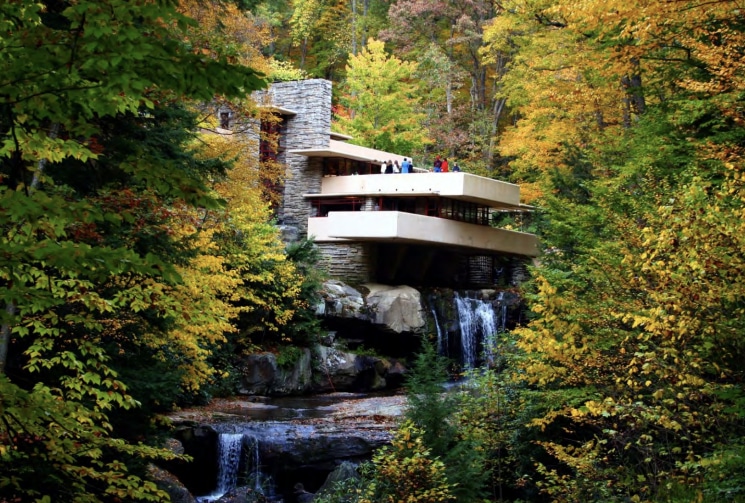
Look closely at this photograph of Fallingwater and answer these questions:
1. A building “site” is land on which that building will be constructed. Describe the natural features of this site in Pennsylvania.
2. Describe the shapes, colors and materials of the building.
3. Describe two building features that Frank Lloyd Wright designed so that people could enjoy a view of the outdoors.
